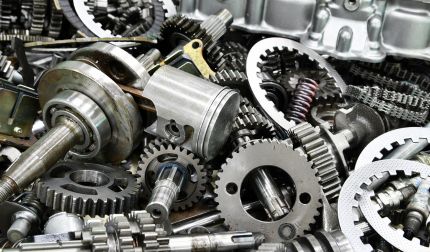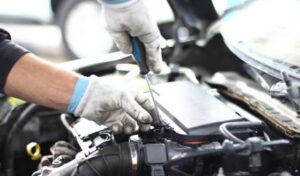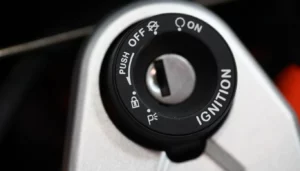Motorcycles have a complex electrical system that powers the ignition and charges the battery. The stator, often overlooked, is crucial to this system. The motorcycle’s alternator’s stator generates AC to charge the battery and power its electrical systems. Every motorbike enthusiast and owner must understand this component’s purpose.
Stator health affects motorcycle performance. A good stator ensures reliable starts, reliable electrical systems, and optimal battery charging. It powers all your bike’s electrical components like the heart. When the stator fails, it causes many problems that can stop your trip or cost a lot to fix. Thus, knowing the signs of a failing stator can prevent roadside issues and unexpected costs.
Components and Functions of a Motorcycle Stator
Motorcycle stators have many parts. Stator core, windings, and lead wires are the main components. The stator core is usually laminated iron or another magnetic material to reduce power loss and optimise magnetic field strength. Windings or coils generate electricity around this core. Lead wires transfer this electricity from the stator to the motorcycle’s electrical system.
The stator generates electricity for the motorcycle’s lights, ignition, and battery charging. It converts engine mechanical energy into electrical energy.
Let’s know about the function of a motorcycle stator:
Power Generation: The Primary Role
Motorcycle stators power the electrical system. The stator’s windings generate an electrical current as the magneto’s flywheel rotates around it. This current powers the bike’s ignition, lights, and battery charging systems.
Ignition System Support: Sparking Life into the Engine
Ignition is a vital stator-powered system. The stator powers spark plugs. No spark, no engine. Thus, the motorcycle’s engine requires a working stator.
Lighting and Accessory Support: Brightening the Ride
The stator powers the motorcycle’s lights and other electronics. The headlight, taillight, indicator lights, dashboard lights and other electrical accessories on your bike are included. These systems may dim or flicker if the stator fails.
Battery Charging: Keeping the Power Reserve Topped Up
Finally, the stator keeps the motorcycle’s battery charged. While the engine runs, the stator charges the battery. The battery stays charged and ready to start the engine and power the electrical systems when the engine is off. Battery drains and failures may result from a failing stator.
Here you can read dirt bike clutch slipping symptoms.
How Does Motorcycle Stators Work?
Motorcycle stators use electromagnetic induction. The crankshaft turns the rotor (flywheel) around the stator as the engine runs. This magnetised rotor spins, creating a fluctuating magnetic field around the stator’s windings.
Faraday’s law of electromagnetic induction states that the rotor’s movement induces an electrical current in the stator’s windings. This current powers the motorcycle’s electrical systems and recharges the battery through the lead wires.
The stator generates power while your motorcycle’s engine is running, ensuring optimal operation.
General Wear and Tear on Motorcycle Stators
Stators wear out like other mechanical parts. Stator windings can fail from prolonged use, high temperatures, and magnetic field fluctuations. Degradation can cause stator shorts or opens, reducing power generation. Excessive wear can damage the stator core, affecting its function.
Motorcycle stators commonly overheat. Motorcycle engines generate heat. Stators can withstand these conditions, but excessive heat can degrade the insulation around the windings, short-circuiting them. This short can disable power generation or damage motorcycle electrical components. Faulty cooling systems, engine overloading, and poor ventilation can cause overheating.
Motorcycle stator performance can suffer from poor wiring. Damaged, corroded, or loose lead wires may prevent the stator’s electrical current from reaching the electrical system. This can cause ineffective charging, power loss, or intermittent electrical system operation, similar to a failing stator. Regular wire and connection inspections can prevent such issues.
Symptoms of a Bad Motorcycle Stator
1. Difficulties in Starting the Motorcycle
One of the most noticeable signs of a bad stator is difficulties in starting the motorcycle. This is primarily because the stator is responsible for supplying the electrical power needed to ignite the spark plugs and start the engine. If the stator is malfunctioning, it may not generate enough power, leading to weak or failed starts.
2. Unusual Noises and Their Possible Implications
While unusual noises can indicate a host of issues with your motorcycle, some might be linked to a failing stator. If the stator’s windings have become loose or the core is damaged, it could produce rattling or grinding noises when the engine runs. Paying close attention to your motorcycle’s normal sound profile and promptly investigating any odd noises can prevent further complications.
3. Motorcycle Battery Drain: Is it the Stator’s Fault?
If you notice that your motorcycle’s battery consistently fails to hold a charge or drains faster than usual, it could be due to a faulty stator. A malfunctioning stator may fail to supply the necessary power to recharge the battery while the engine runs. However, remember that a weak battery could also be a symptom of other electrical issues, so it’s crucial to test the stator before concluding it’s the source of the problem.
4. Frequent Flickering or Failure of Motorcycle Lights
Inconsistent operation or frequent flickering of your motorcycle’s headlights, brake lights, or dashboard lights can indicate an issue with the stator. Since the stator supplies the power needed for these electrical systems, a failing stator may cause fluctuating voltage that results in flickering lights or intermittent system failures.
5. Irregular Voltage Readings and the Stator’s Role
One of the most concrete signs of a bad stator is irregular voltage output. If you are noticing any of the above symptoms, a voltage test can provide definitive evidence of a stator issue. If the stator is healthy, it should produce a consistent voltage output in accordance with the manufacturer’s specifications. A reading that is significantly higher or lower can suggest a malfunctioning stator.
Conducting Self-Diagnosis
The Multimeter Test: A Guide to Using a Multimeter for Checking the Stator
Motorcycle stator health can be checked with a multimeter. Before diagnosing a stator with a multimeter, disconnect it from the bike’s electrical system. Then, connect the probes to the stator’s lead wires and set the multimeter to resistance (ohms). A healthy stator has a reading within the manufacturer’s range, while a significantly different reading indicates a faulty one. Setting the multimeter to AC voltage lets you check the stator’s voltage output while the engine is running.
The Battery Test: How a Simple Battery Check Can Indicate Stator Health
Battery tests can also indicate stator health. Connect a voltmeter to the motorcycle battery terminals after fully charging it. Healthy batteries have 12.6 volts. Start the engine and watch the voltage rise to 13.5-14.5 volts. If the voltage doesn’t rise or rises excessively, the stator may not be charging the battery properly.
Visual Inspection: What to Look For
Visual inspection can reveal a bad stator. Burned areas, melted insulation, and loose windings indicate stator damage. Check the stator’s lead wires and connections for corrosion, damage, or looseness. To avoid electric shock, disconnect the battery before visual inspection.
Repairing or Replacing a Bad Stator
When to Repair or Replace: Factors to Consider
You may wonder whether to repair or replace a bad stator. Several factors influence the choice. Repairing loose or lightly damaged stator windings may be enough. If the stator is badly burned, melted, or damaged, replacing it is usually best. Repair vs. replacement cost and quality spare parts also factor in.
DIY Repairs: Tips and Precautions
There are a few things to remember if you repair or replace the stator yourself. Before starting, disconnect the battery to avoid electric shock. Before starting, make sure you understand the process. Mistakes can cause more damage. Using the right tools and following the motorcycle’s service manual makes the job easier. Test the stator after repair or replacement.
Professional Repairs: What to Expect
If you’re not comfortable fixing or replacing it, hire a pro. To confirm that the stator is the problem, a professional will diagnose your motorcycle. They’ll then recommend repair or replacement. Avoid surprises by asking about costs beforehand. The mechanic should test the stator after repair or replacement.
Preventative Measures and Maintenance
Routine Checks and Maintenance to Prolong Stator Life
Motorcycle stators can last longer with regular maintenance. Check the stator and wiring for damage, corrosion, and loose connections. A multimeter can detect problems before they become serious by periodically checking the stator’s resistance and output voltage. Maintaining the engine and not overloading the motorcycle can also prevent stator overheating.
Importance of Regular Servicing and Professional Inspections
Regular servicing and professional inspections should be prioritised over DIY checks. A professional can inspect your motorcycle’s electrical system, identify early stator issues, and repair or replace it. They can also advise on motorcycle stator maintenance. Regular service can prevent stator failures and keep your motorcycle road-ready.
Frequently Asked Questions
How long does a motorcycle stator typically last?
Motorcycle stator lifespan depends on bike model, riding conditions, and motorcycle maintenance. A stator lasts 20,000–100,000 miles. Overheating or faulty wiring can shorten this lifespan.
Can a bad stator ruin a motorcycle battery?
Bad stators can damage motorcycle batteries. If the stator is underpowered, the battery will discharge without being recharged, shortening its lifespan. A stator that generates too much power can overcharge and damage the battery.
What is the average cost of replacing a motorcycle stator?
Whether you do it yourself or hire a professional, replacing a motorcycle stator costs depends on the bike’s make and model. According to my 2021 update, a new stator costs $100 to $400 and labour $150 to $300. Get several quotes because prices can vary.
Is it safe to ride with a failing stator?
Motorcycles with failing stators should not be ridden. A faulty stator can cut power to the motorcycle’s electrical systems, killing the engine or lights. This could be dangerous, especially at night or high speeds.
Can I replace a motorcycle stator myself or should I hire a professional?
Your mechanical ability determines whether you can replace a stator. You can replace the stator yourself if you’re familiar with motorcycle maintenance, have the right tools, and can follow the service manual. To avoid damage, hire a professional if you’re unsure or uncomfortable.
Conclusion
Your motorcycle’s stator improves performance and reliability. Knowing the signs of a bad stator—difficulty starting the bike, unusual noises, battery drain, flickering lights, or irregular voltage readings—can prevent more serious issues. Biker’s self-diagnosis tools include multimeter, battery, and visual inspections. However, only professional servicing and inspections can ensure your bike’s electrical system’s health.
Understanding the role of a stator and its symptoms can help you keep your motorbike in top condition for any trip.






